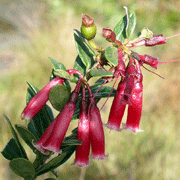James L. Luteyn and Paola Pedraza-Peñalosa
The New York Botanical Garden
|
|
Siphonandra is a distinctive, neotropical genus of 3 species, endemic to southern Peru and northern Bolivia. It is characterized by connate filaments, tubules with terminal pores, and an articulate calyx. |
SIPHONANDRA Klotzsch, Linnaea 24: 24. 1851. Ceratostema Juss. sect. Siphonandra (Klotzsch) Hook.f. ex Benth. & Hook.f., Gen. pl. 2: 570 p.p. 1876. Type: Siphonandra elliptica (Ruiz & Pavón ex Don) Klotzsch.
Terrestrial or often epiphytic shrubs; bud scales not stipular. Leaves alternate, coriaceous, evergreen, margin recurved and entire or faintly crenulate, pinnately nerved, short-petiolate. Inflorescence axillary, racemose, with 5-15 pedicellate flowers; floral bract inconspicuous; bracteoles 2. Flowers 5-merous, without odor; aestivation valvate; calyx articulate with pedicel; hypanthium short-cylindric; limb spreading; lobes 5; corolla cylindric; stamens 10, equal, slightly longer than corolla; filaments equal, connate, shorter than anthers; anthers basifixed, lacking spurs, lacking, disintegration tissue; thecae granular; tubules elongate, thin, flexible, about half as wide (or less) as thecae, 4-5 times longer than thecae, dehiscing by strictly terminal, flaring pores; pollen without viscin threads; ovary inferior; style filiform, slightly exserted; nectariferous disc annular (?). Fruit a spherical berry.
Key to Neotropical Species Back to Top
1. Filaments distinct; rachis to 0.5 cm long; calyx ca.
9 mm long; corolla 35-37 mm long........................ Siphonandra magnifica
1. Filaments connate; rachis 2-5 cm long; calyx 7-8 mm
long; corolla 25-48 mm long ................................. (2)
2. Corolla ca. 25 mm long ...................................... Siphonandra elliptica
2. Corolla 43-48 mm long ..................................... Siphonandra boliviana
